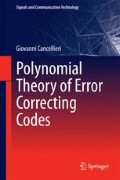Abstract
The traditional description of low-rate convolutional codes is presented. They are interpreted as strict-sense time-invariant in their generator matrix, where an interleaved generator polynomial shifts by a period any time. State diagrams are depicted with reference to the encoder circuit constructed by means of a shift register in controller arrangement. The minimum distance is calculated in this state diagram. Code puncturation is adopted in order to obtain higher code rates. A recursive systematic encoder circuit is described. An important equivalence between modified lengthened cyclic codes and s.s. time-invariant convolutional codes is demonstrated. A first conceptual bridge between cyclic block codes and convolutional codes is presented, showing that the interleaved generator polynomials of many interesting convolutional codes coincide with the generator polynomials of well-known cyclic block codes, mainly Hamming codes. A catastrophic convolutional code is described. In its systematic version it is no longer catastrophic but remains a not well-designed convolutional code, characterized by a more than linear growth in the number of low-weight code frames with the number of periods in the frame. A tail-biting arrangement is introduced, in order to pay a null cost in correct frame termination, so the asymptotic code rate can become the true code rate on whichever frame length. Nevertheless, the frame weight distribution may be penalized when the frame length is too short, especially if the convolutional code is not well designed. Finally, the trellis of a convolutional code is constructed, where the computational complexity of a soft-decision decoding, performed according to Viterbi algorithm, can be easily evaluated. In this sense, the generator constraint length expresses a very important parameter for the design of such type of codes.
Access this chapter
Tax calculation will be finalised at checkout
Purchases are for personal use only
References
Barbier J, Sicot G, Houcke S (2006) Algebraic approach for the reconstruction of linear and convolutional error correcting codes. Int J Appl Math Comput Sci 2:113–118
Berrou C, Glavieux A, Thitimajshima P (1993) Near Shannon limit error correcting coding and decoding: turbo codes. In: Proceedings of IEEE international conference communications (ICC93), Geneva, pp 1064–1070
Bossert M (1999) Channel coding for telecommunications. Wiley, Weinheim
Cain JB, Clark GC, Geist JM (1979) Punctured convolutional codes at rate (n − 1)/n and simplified maximum likelihood decoding. IEEE Trans Inf Theor 25:97–100
Calderbank AR, Forney GD, Vardy A (1998) Minimal tail-biting trellises: the Golay code and more. In: Proceedings of ISIT 1998, Cambridge, USA, p 255
Elias P (1955) Coding for noisy channels. In: IRE Convention Rec Part 4, pp 37–46
Forney GD (1970) Convolutional codes I: algebraic structure. IEEE Trans Inf Theor 16:720–738
Hagenauer J, Hoeher P (1989) A Viterbi algorithm with soft-decision outputs and its applications. In: Proceedings of IEEE global telecom conference, Dallas, pp 1680–1686
Johannesson R, Zigangirov KS (1999) Fundamentals of convolutional coding. IEEE Press, New York
Larsen KJ (1973) Short convolutional codes with maximal free distance for rates 1/2, 1/3 and 1/4. IEEE Trans Inf Theor 19:371–372
Lin S, Costello DJ (2004) Error control coding. Pearson/Prentice-Hall, Upper Saddle River
Mason S, Zimmerman H (1960) Electronic circuits, signals and systems. Wiley, New York
Massey JL, Sain MK (1968) Inverses of linear sequential circuits. IEEE Trans Comput 17:330–337
Proakis JC (1983) Digital communications. McGraw Hill, Tokyo
Solomon G, Van Tilborg HCA (1979) A connection between block and convolutional codes. SIAM J Appl Math 37:358–369
Viterbi AJ (1967) Error bounds for convolutional codes and an asymptotically optimum decoding algorithm. IEEE Trans Inf Theor 13:260–269
Wicker SB (1995) Error control systems for digital communications and storage. Prentice-Hall, Englewood Cliffs
Yasuda Y, Kashiki K, Hirata Y (1984) High rate punctured convolutional codes for soft-decision Viterbi decoding. IEEE Trans Commun 32:315–319
Author information
Authors and Affiliations
Corresponding author
Rights and permissions
Copyright information
© 2015 Springer International Publishing Switzerland
About this chapter
Cite this chapter
Cancellieri, G. (2015). Generator Matrix Approach to s.s. Time-Invariant Convolutional Codes. In: Polynomial Theory of Error Correcting Codes. Signals and Communication Technology. Springer, Cham. https://doi.org/10.1007/978-3-319-01727-3_3
Download citation
DOI: https://doi.org/10.1007/978-3-319-01727-3_3
Published:
Publisher Name: Springer, Cham
Print ISBN: 978-3-319-01726-6
Online ISBN: 978-3-319-01727-3
eBook Packages: EngineeringEngineering (R0)

